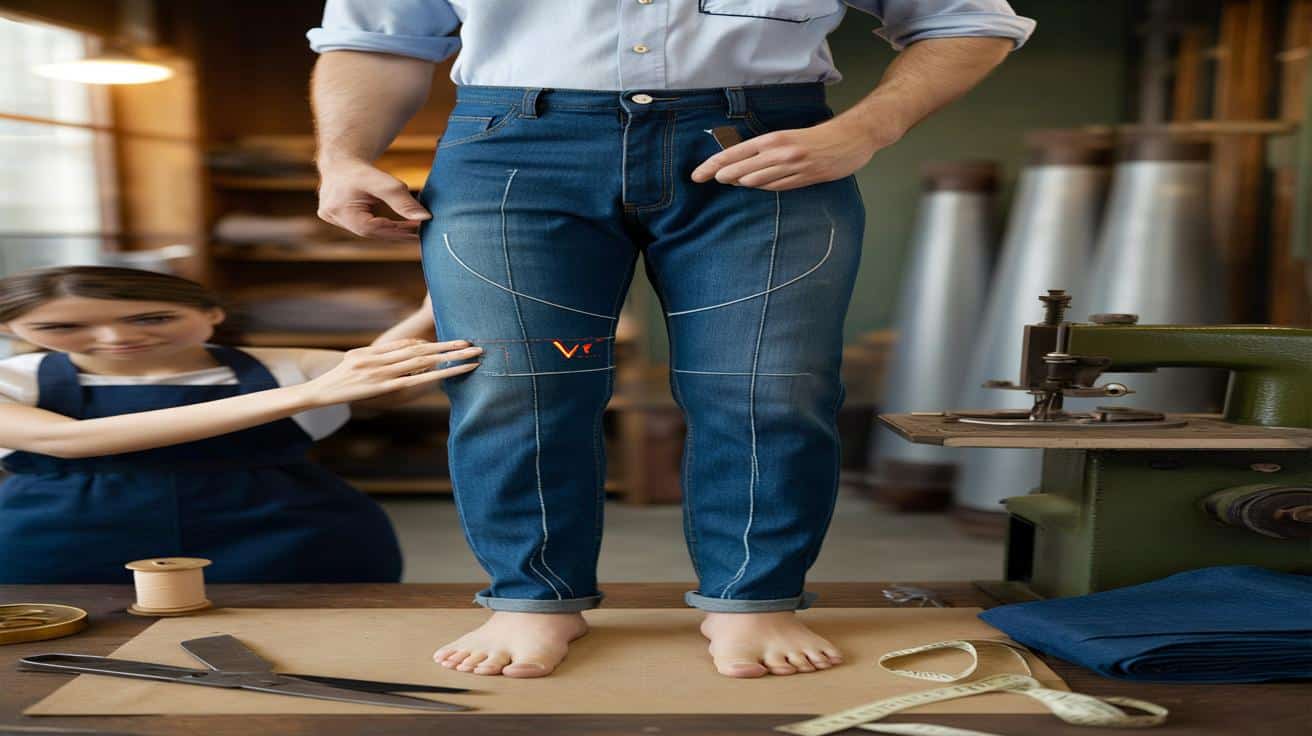The leg reads slim and straight, yet a millimetre too tight at the calf or a whisper too loose at the waist and the whole silhouette tips into “almost”. This is where jean tailors quietly earn their halos.
The shop was humming, dryers rolling somewhere at the back, when a tailor in a navy apron asked me to step onto a low wooden platform. He tugged at the waistband, tapped the side seam with a chalk nub, and waited for the denim to relax the way a violinist waits for a string to settle. I could feel the pinch at my thigh melt as he shifted the grain with two fingers, barely any force at all, just accuracy. I’d never noticed how a good tailor reads your jeans like a map, then redraws the borders. Then he reached for the chalk.
What tailors know about cigarette jeans that shops don’t
Off-the-peg cigarette jeans promise a clean line, but bodies aren’t factory-shaped. Tailors talk about three curves you can’t see on a hanger: the waist circle, the seat scoop, and the leg funnel. Get those three in balance and everything else—wrinkles, drag lines, odd twisting—calms down around the **grainline**.
Take Maya, a creative producer who cycled to the studio every day. Her favourite pair looked sharp standing up and miserable on the bike: a gaping waist, smile lines under the bum, and knees that felt like armour. The tailor added a tiny V-dart hidden in the back yoke, scooped the back rise by 5 mm, and eased the thigh by taking less from the inseam. He reattached the original hem to keep the fade. She sent a message a week later: “Same jeans. Different life.”
The logic is simple: remove width where the leg doesn’t need to flex, preserve it where it does. Taper from the outseam if you want to keep the inner leg smooth for movement; from the inseam if the outer silhouette already looks balanced. Keep the knee point where your leg actually bends, then taper to the hem so the **back-rise** isn’t forced to do the work of a **calf taper**. The denim stops fighting you.
Hands-on customisations you can try or request
Start with a basted fit. Turn the jeans inside out, put them on, and pinch the excess at the waist, thigh, and calf with clips or safety pins. Mark the pinches with chalk lines, then take them off and hand-baste along those lines to test the change before committing to stitches. A 3–8 mm reduction along the outseam from knee to hem cleans the line without calf bite; 5–10 mm scooped from the seat can erase drag lines without flattening the bum.
We’ve all had that moment when you tug at the leg on the bus and feel the denim snap back like a rubber band. Resist the urge to over-taper—tight calves create “strangle rings” and blow out faster. Sit, squat, climb stairs, drive. Put your phone in the pocket and try again. Let’s be honest: nobody really does that every day. Do it once here and you’ll thank yourself for a year.
Here’s how pros think when they tune a slim profile.
“Cigarette jeans don’t forgive poor balance,” says Ade, a London denim tailor. “If the knee is even 2 cm too high, your hem flares or bites. We fix the map, then the mile.”
- Waist: Close a gape with a hidden fisheye dart or a yoke trim rather than chopping the side seams.
- Seat: A 3–6 mm back crotch scoop smooths whiskers more safely than pulling the side seams in.
- Thigh: Split reductions between in- and outseam to keep the leg hanging straight.
- Knee: Locate it where your leg bends; taper starts there, not at the thigh.
- Hem: Reattach the original hem to preserve roping and fade; match stitch colour and tension.
The joy of perfect balance
Once you feel a dialled-in cigarette fit, you don’t chase the next pair—you refine the one you’ve got. Your stride changes, the denim stops arguing, shoes look more intentional, and tops sit better because the whole lower half is calmer. That’s the secret: subtle work that nobody sees yet everyone reads as poise.
The best part is how repeatable it becomes. You learn your knee height, your seat scoop, your real waist on a jeans waistband, not a tape. You learn how much taper your calves tolerate before the hem kicks. Share those numbers with a tailor and you get a consistent silhouette across brands without buying five sizes “just in case”. The mirror suddenly feels like a friend.
If you want to go deeper, ask for small things with big effects. A contoured waistband that dips 5–8 mm at centre front keeps shirts tucked and stomachs comfortable. A micro-gusset hidden inside the back seam rescues a favourite pair that shrank after a hot wash. A bar tack added to the pocket corners stops the sag that makes front pockets splay. Quiet upgrades. Long dividends.
| Point clé | Détail | Intérêt pour le lecteur |
|---|---|---|
| Waist contouring | Use a hidden fisheye dart or trim the yoke to close a gap without warping the side seam | Cleaner back view, no belt-cinch bulge, shirts stay put |
| Knee placement | Mark your true knee in wear, start taper from that point to the hem | Slim look without calf bite or odd hem kick |
| Original hem (Euro hem) | Detach, shorten above, and reattach the original to keep roping and fade | Shorter inseam with “worn-in” authenticity intact |
FAQ :
- How tight should cigarette jeans feel at the calf?A credit card should slide down inside the leg without snagging. If it sticks, you’ve over-tapered.
- Can a tailor let jeans out if they’re too tight?Often a little. Many jeans have 6–10 mm of seam allowance at the outseam or back seam; not all brands do. Ask before buying if you plan to alter.
- What’s the best hem finish for cigarette jeans?A chain-stitch rehem or original hem reattachment keeps the classic “rope” effect. Match thread thickness and colour for invisibility.
- Is stretch denim easier to fit?It’s more forgiving but hides errors that show later. Aim for balance first, then enjoy the comfort of stretch as a bonus.
- Should I wash before alterations?If the denim is raw or rigid, yes—wash and dry as you’ll treat them in real life. Pre-washed pairs can go straight to fitting.









I finally understand why my slim jeans looked “almost.” The way you break down waist circle, seat scoop, and leg funnel makes total sense, and the bit about keeping the knee point honest is a reallly helpful check. I tried a tiny back-rise scoop on an old pair (hand-basted first), and the drag lines calmed down without flattening the seat—wild. Also, tapering from the outseam to save inner-leg movement is a tip I’d defintely missed. This reads like a map, not hype.
Does “shifting the grain” with fingers actually last after the first wash/dry cycle, or is that just fitter’s finesse during the basted fit? Also, what’s a realistic price/timeframe for a knee re-mark + slight calf taper + original-hem reattach in a big city? I’m wary of overpaying for micro tweaks that won’t hold. Any durablity differences between chain-stitch rehem vs lockstitch on midweight non-stretch selvedge?